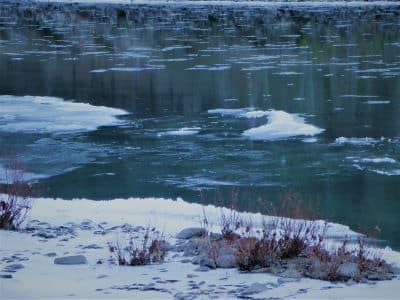Then, at his command, it all melts. He sends his winds, and the ice thaws. – Psalm 147:18 NLT
On the last day, the climax of the festival, Jesus stood and shouted to the crowds, “Anyone who is thirsty may come to me! Anyone who believes in me may come and drink! For the Scriptures declare, ‘Rivers of living water will flow from the heart of anyone who believes in me. – John 7:37-38 NLT
As I mentioned in an earlier post, most people living in colder climates have experienced water in three forms – liquid, solid (ice), and gas (vapor). And usually, when water freezes, it floats. To learn why, and to see a situation when ice can occur at the bottom of a body of water, rather than floating on the surface, see Anchor Ice.
When warming spring temperatures rise above freezing (320 Fahrenheit), ice which was formed in high mountain rivers and streams begins to melt. Pieces of ice break loose from the banks and drift downstream. If the rising temperatures are gradual, typically these floating chunks of ice slowly melt on their way downriver, having little impact on the surrounding environment.
But if weather conditions change rapidly, such as higher-than-normal temperatures, heavy rainfalls, or a large ice-dam breaking up, major events can take place downstream. Riverbanks and bottoms can be scoured, trees and other items on the banks can be pushed into the river, and even roads and bridges can be damaged or destroyed. The power behind moving water has never ceased to amaze me. And when the water is pushing large chunks of ice downriver, it is best to get out of the way!
Fortunately, there is a very powerful river which can bring life and not destruction. Jesus talks about it in the second passage cited above. Rivers of living water. Not just a cup or glass of water, but rivers. If you have never experienced this, I encourage you to look at Got God?
Hope you have a great day.


 Deer and the Weather – III
Deer and the Weather – III
Leave a Reply